Capital Structure and Risk Management: A Detailed Analysis of AMP Ltd
VerifiedAdded on 2023/06/04
|8
|1502
|446
Report
AI Summary
This report provides a comprehensive analysis of AMP Limited's capital structure and risk management system. It begins with an introduction to the company and an evaluation of its current capital structure, including the calculation of the Weighted Average Cost of Capital (WACC) and cost of equity. The report compares AMP's capital structure with that of its competitor, Commonwealth Bank, and analyzes key financial ratios to determine AMP's performance. Significant changes in the company's capital structure are identified, along with an assessment of its management of seven identified risks. The report concludes that AMP needs to improve its capital structure by increasing its debt component and maintaining its liquidity position, while also addressing previously unmanaged risks to ensure effective risk management.
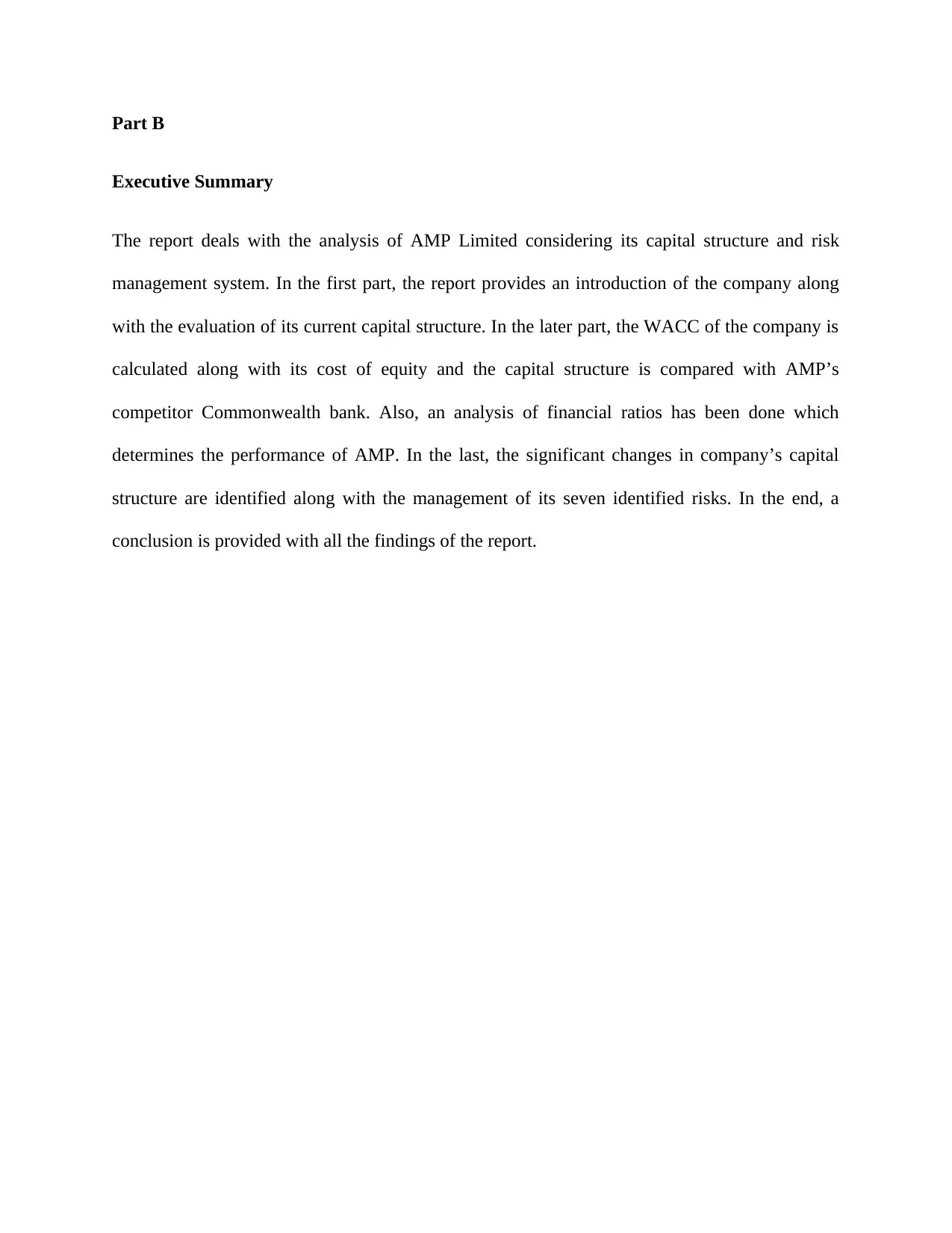
Part B
Executive Summary
The report deals with the analysis of AMP Limited considering its capital structure and risk
management system. In the first part, the report provides an introduction of the company along
with the evaluation of its current capital structure. In the later part, the WACC of the company is
calculated along with its cost of equity and the capital structure is compared with AMP’s
competitor Commonwealth bank. Also, an analysis of financial ratios has been done which
determines the performance of AMP. In the last, the significant changes in company’s capital
structure are identified along with the management of its seven identified risks. In the end, a
conclusion is provided with all the findings of the report.
Executive Summary
The report deals with the analysis of AMP Limited considering its capital structure and risk
management system. In the first part, the report provides an introduction of the company along
with the evaluation of its current capital structure. In the later part, the WACC of the company is
calculated along with its cost of equity and the capital structure is compared with AMP’s
competitor Commonwealth bank. Also, an analysis of financial ratios has been done which
determines the performance of AMP. In the last, the significant changes in company’s capital
structure are identified along with the management of its seven identified risks. In the end, a
conclusion is provided with all the findings of the report.
Paraphrase This Document
Need a fresh take? Get an instant paraphrase of this document with our AI Paraphraser
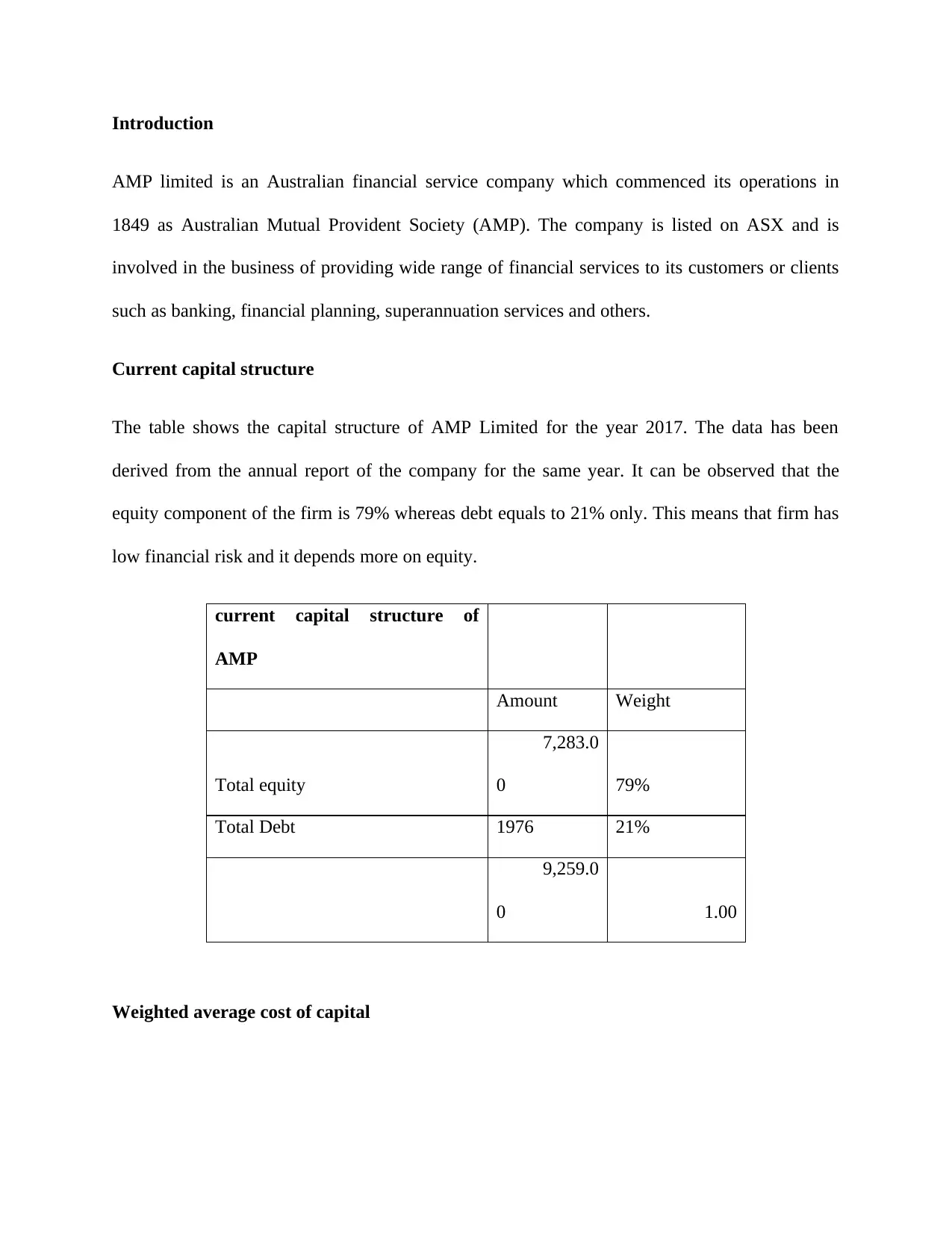
Introduction
AMP limited is an Australian financial service company which commenced its operations in
1849 as Australian Mutual Provident Society (AMP). The company is listed on ASX and is
involved in the business of providing wide range of financial services to its customers or clients
such as banking, financial planning, superannuation services and others.
Current capital structure
The table shows the capital structure of AMP Limited for the year 2017. The data has been
derived from the annual report of the company for the same year. It can be observed that the
equity component of the firm is 79% whereas debt equals to 21% only. This means that firm has
low financial risk and it depends more on equity.
current capital structure of
AMP
Amount Weight
Total equity
7,283.0
0 79%
Total Debt 1976 21%
9,259.0
0 1.00
Weighted average cost of capital
AMP limited is an Australian financial service company which commenced its operations in
1849 as Australian Mutual Provident Society (AMP). The company is listed on ASX and is
involved in the business of providing wide range of financial services to its customers or clients
such as banking, financial planning, superannuation services and others.
Current capital structure
The table shows the capital structure of AMP Limited for the year 2017. The data has been
derived from the annual report of the company for the same year. It can be observed that the
equity component of the firm is 79% whereas debt equals to 21% only. This means that firm has
low financial risk and it depends more on equity.
current capital structure of
AMP
Amount Weight
Total equity
7,283.0
0 79%
Total Debt 1976 21%
9,259.0
0 1.00
Weighted average cost of capital
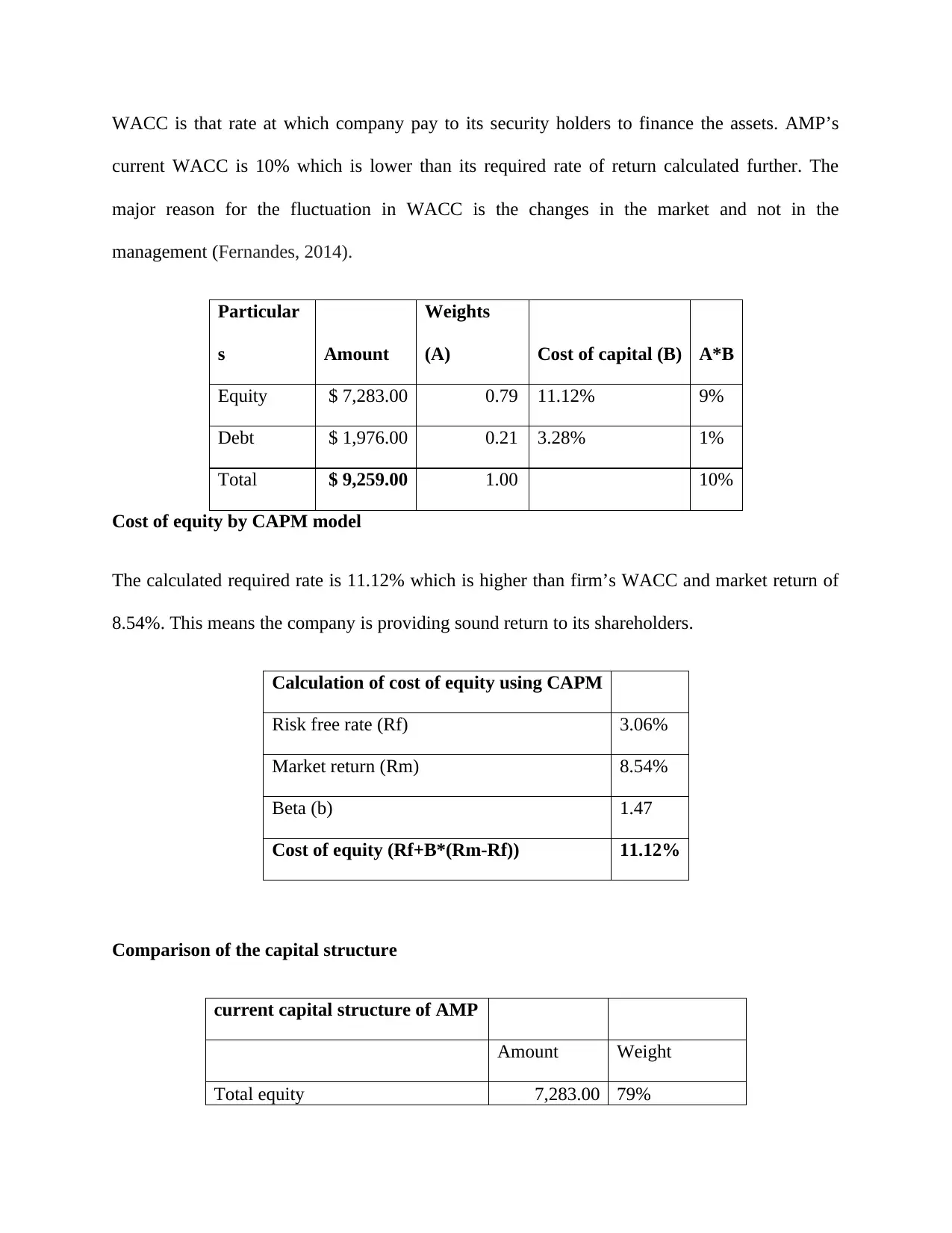
WACC is that rate at which company pay to its security holders to finance the assets. AMP’s
current WACC is 10% which is lower than its required rate of return calculated further. The
major reason for the fluctuation in WACC is the changes in the market and not in the
management (Fernandes, 2014).
Particular
s Amount
Weights
(A) Cost of capital (B) A*B
Equity $ 7,283.00 0.79 11.12% 9%
Debt $ 1,976.00 0.21 3.28% 1%
Total $ 9,259.00 1.00 10%
Cost of equity by CAPM model
The calculated required rate is 11.12% which is higher than firm’s WACC and market return of
8.54%. This means the company is providing sound return to its shareholders.
Calculation of cost of equity using CAPM
Risk free rate (Rf) 3.06%
Market return (Rm) 8.54%
Beta (b) 1.47
Cost of equity (Rf+B*(Rm-Rf)) 11.12%
Comparison of the capital structure
current capital structure of AMP
Amount Weight
Total equity 7,283.00 79%
current WACC is 10% which is lower than its required rate of return calculated further. The
major reason for the fluctuation in WACC is the changes in the market and not in the
management (Fernandes, 2014).
Particular
s Amount
Weights
(A) Cost of capital (B) A*B
Equity $ 7,283.00 0.79 11.12% 9%
Debt $ 1,976.00 0.21 3.28% 1%
Total $ 9,259.00 1.00 10%
Cost of equity by CAPM model
The calculated required rate is 11.12% which is higher than firm’s WACC and market return of
8.54%. This means the company is providing sound return to its shareholders.
Calculation of cost of equity using CAPM
Risk free rate (Rf) 3.06%
Market return (Rm) 8.54%
Beta (b) 1.47
Cost of equity (Rf+B*(Rm-Rf)) 11.12%
Comparison of the capital structure
current capital structure of AMP
Amount Weight
Total equity 7,283.00 79%
⊘ This is a preview!⊘
Do you want full access?
Subscribe today to unlock all pages.

Trusted by 1+ million students worldwide
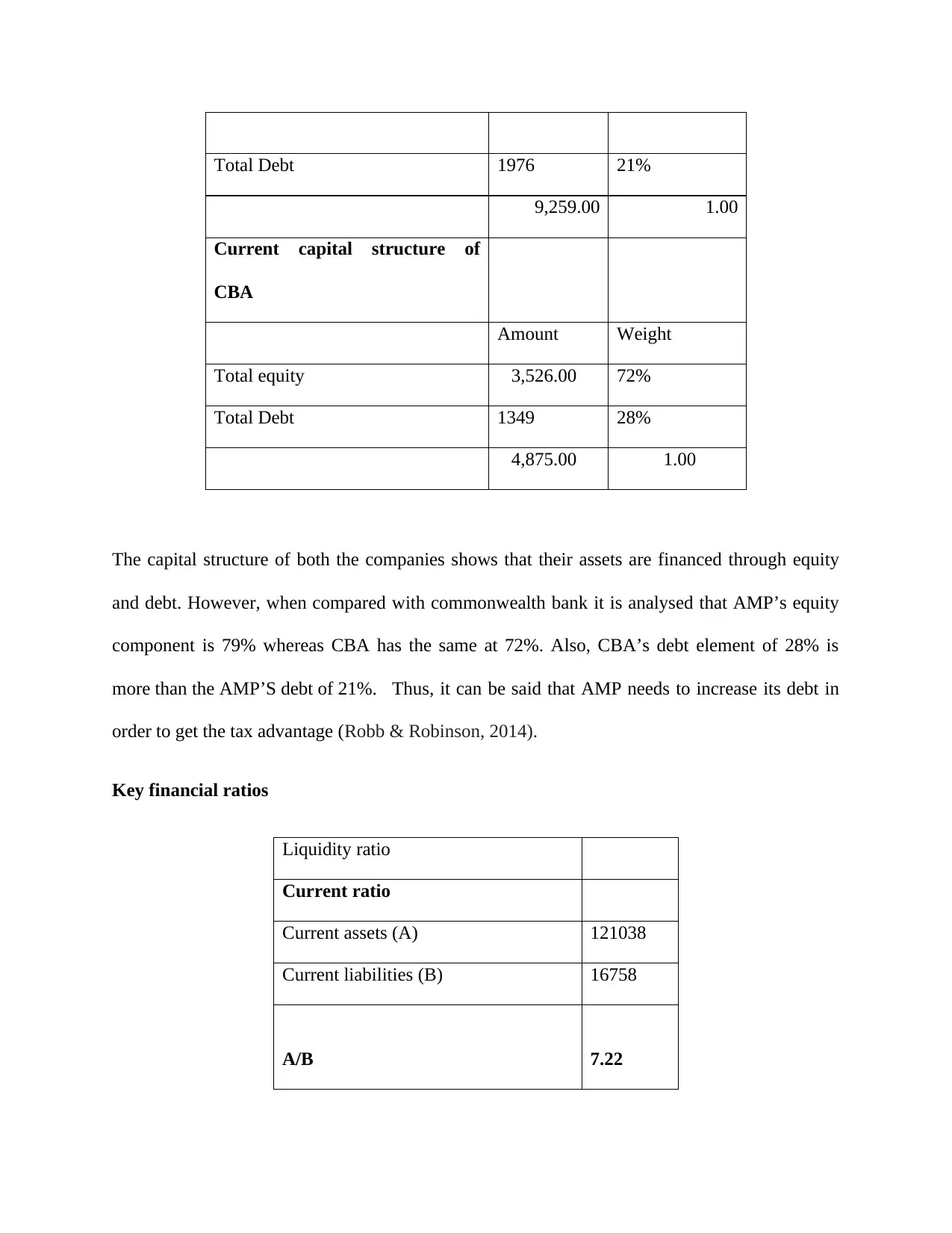
Total Debt 1976 21%
9,259.00 1.00
Current capital structure of
CBA
Amount Weight
Total equity 3,526.00 72%
Total Debt 1349 28%
4,875.00 1.00
The capital structure of both the companies shows that their assets are financed through equity
and debt. However, when compared with commonwealth bank it is analysed that AMP’s equity
component is 79% whereas CBA has the same at 72%. Also, CBA’s debt element of 28% is
more than the AMP’S debt of 21%. Thus, it can be said that AMP needs to increase its debt in
order to get the tax advantage (Robb & Robinson, 2014).
Key financial ratios
Liquidity ratio
Current ratio
Current assets (A) 121038
Current liabilities (B) 16758
A/B 7.22
9,259.00 1.00
Current capital structure of
CBA
Amount Weight
Total equity 3,526.00 72%
Total Debt 1349 28%
4,875.00 1.00
The capital structure of both the companies shows that their assets are financed through equity
and debt. However, when compared with commonwealth bank it is analysed that AMP’s equity
component is 79% whereas CBA has the same at 72%. Also, CBA’s debt element of 28% is
more than the AMP’S debt of 21%. Thus, it can be said that AMP needs to increase its debt in
order to get the tax advantage (Robb & Robinson, 2014).
Key financial ratios
Liquidity ratio
Current ratio
Current assets (A) 121038
Current liabilities (B) 16758
A/B 7.22
Paraphrase This Document
Need a fresh take? Get an instant paraphrase of this document with our AI Paraphraser
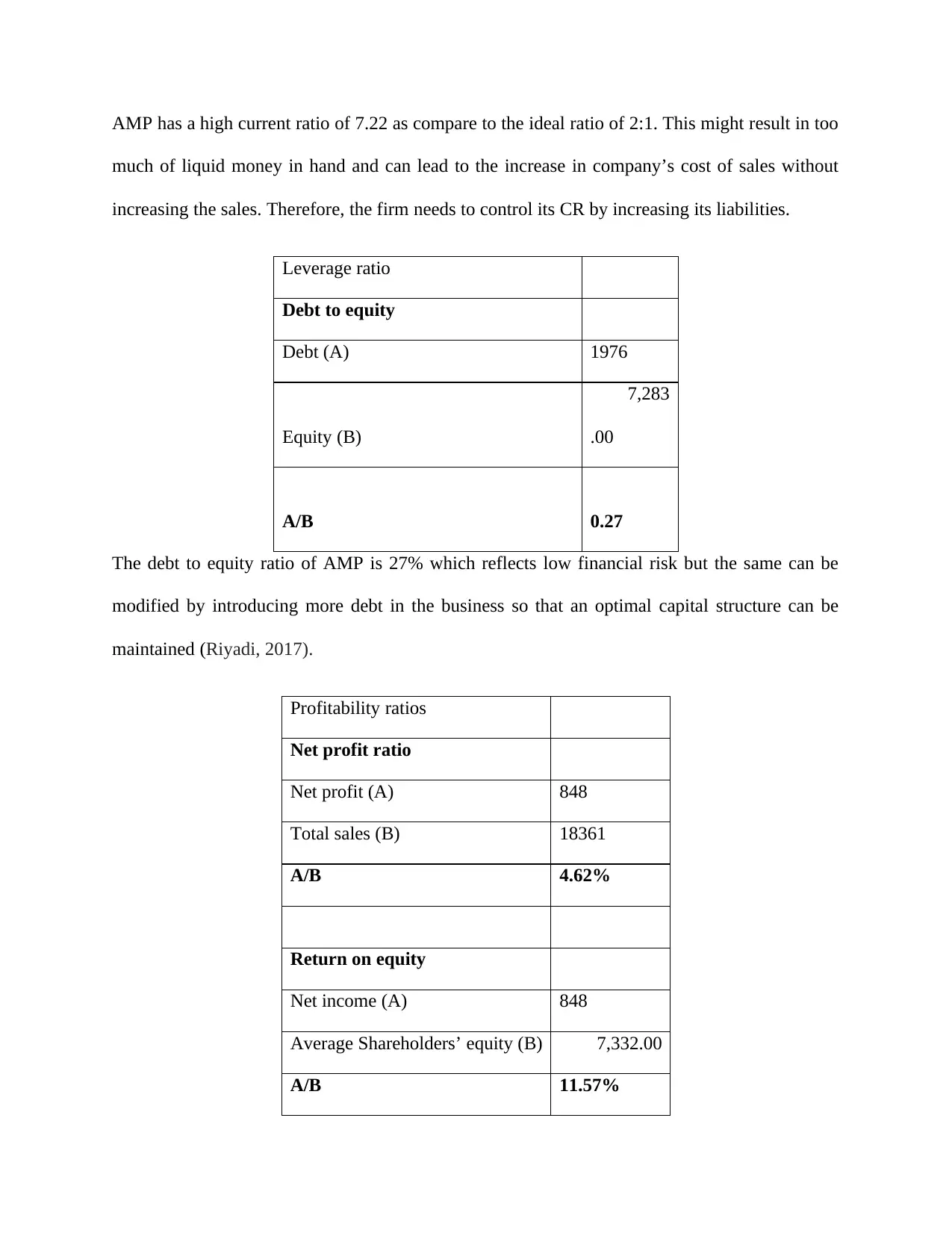
AMP has a high current ratio of 7.22 as compare to the ideal ratio of 2:1. This might result in too
much of liquid money in hand and can lead to the increase in company’s cost of sales without
increasing the sales. Therefore, the firm needs to control its CR by increasing its liabilities.
Leverage ratio
Debt to equity
Debt (A) 1976
Equity (B)
7,283
.00
A/B 0.27
The debt to equity ratio of AMP is 27% which reflects low financial risk but the same can be
modified by introducing more debt in the business so that an optimal capital structure can be
maintained (Riyadi, 2017).
Profitability ratios
Net profit ratio
Net profit (A) 848
Total sales (B) 18361
A/B 4.62%
Return on equity
Net income (A) 848
Average Shareholders’ equity (B) 7,332.00
A/B 11.57%
much of liquid money in hand and can lead to the increase in company’s cost of sales without
increasing the sales. Therefore, the firm needs to control its CR by increasing its liabilities.
Leverage ratio
Debt to equity
Debt (A) 1976
Equity (B)
7,283
.00
A/B 0.27
The debt to equity ratio of AMP is 27% which reflects low financial risk but the same can be
modified by introducing more debt in the business so that an optimal capital structure can be
maintained (Riyadi, 2017).
Profitability ratios
Net profit ratio
Net profit (A) 848
Total sales (B) 18361
A/B 4.62%
Return on equity
Net income (A) 848
Average Shareholders’ equity (B) 7,332.00
A/B 11.57%

The NPR of the firm accounted at 4.62% which is lower than the previous years. This was due to
the low profits made by the firm during 2017 due to increased cost of goods sold. As far as return
on equity is concerned, it was at 11.57% which shows company offer reasonable returns to its
shareholders (Chowdhury, 2018).
Market value ratio
P/E ratio
Market price (A) 3.19
EPS (B) 0.115
A/B
2
7.74
P/E Ratio determines the willingness of an investor to pay for each dollar of earnings. AMP’s
P/E ratio was 27.74 because of the increased market price of the AMP’s share.
However, there are some certain areas where the company needs to improve such as liquidity and
profitability.
Significant changes in capital structure
There are various changes which have taken place in the capital structure of AMP Limited over
the past three years. In 2015, its equity was 56% which increased to 79% in 2017. Similarly its
debt component was 44% in 2015 which reduced to 21% in 2017. Initially, it had a preferred
capital structure but later on as the debt reduced the structure got imbalanced. AMP should
improve its debt element to avail tax benefits and maintain a balance between equity and debt.
Identification and management of risk
the low profits made by the firm during 2017 due to increased cost of goods sold. As far as return
on equity is concerned, it was at 11.57% which shows company offer reasonable returns to its
shareholders (Chowdhury, 2018).
Market value ratio
P/E ratio
Market price (A) 3.19
EPS (B) 0.115
A/B
2
7.74
P/E Ratio determines the willingness of an investor to pay for each dollar of earnings. AMP’s
P/E ratio was 27.74 because of the increased market price of the AMP’s share.
However, there are some certain areas where the company needs to improve such as liquidity and
profitability.
Significant changes in capital structure
There are various changes which have taken place in the capital structure of AMP Limited over
the past three years. In 2015, its equity was 56% which increased to 79% in 2017. Similarly its
debt component was 44% in 2015 which reduced to 21% in 2017. Initially, it had a preferred
capital structure but later on as the debt reduced the structure got imbalanced. AMP should
improve its debt element to avail tax benefits and maintain a balance between equity and debt.
Identification and management of risk
⊘ This is a preview!⊘
Do you want full access?
Subscribe today to unlock all pages.

Trusted by 1+ million students worldwide
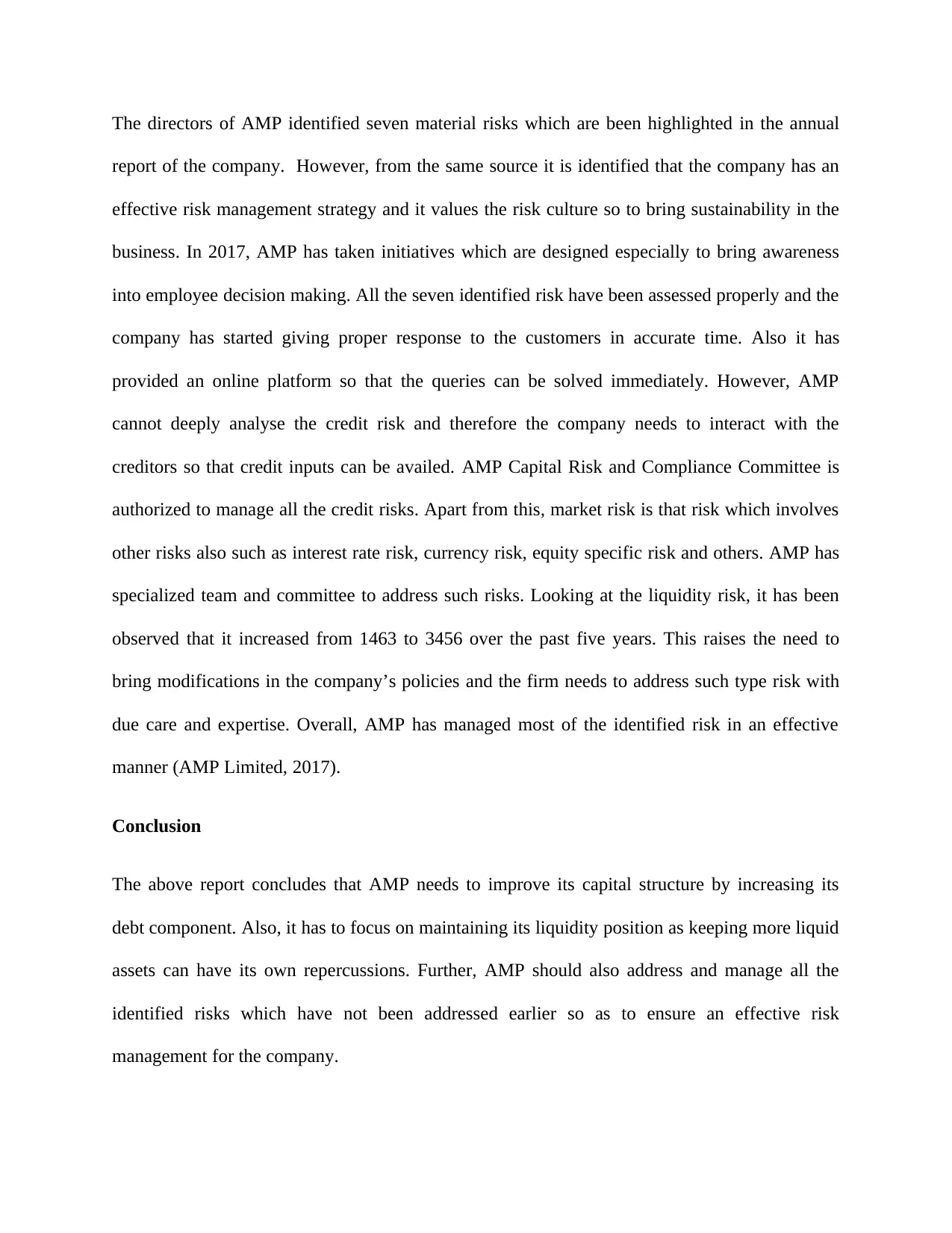
The directors of AMP identified seven material risks which are been highlighted in the annual
report of the company. However, from the same source it is identified that the company has an
effective risk management strategy and it values the risk culture so to bring sustainability in the
business. In 2017, AMP has taken initiatives which are designed especially to bring awareness
into employee decision making. All the seven identified risk have been assessed properly and the
company has started giving proper response to the customers in accurate time. Also it has
provided an online platform so that the queries can be solved immediately. However, AMP
cannot deeply analyse the credit risk and therefore the company needs to interact with the
creditors so that credit inputs can be availed. AMP Capital Risk and Compliance Committee is
authorized to manage all the credit risks. Apart from this, market risk is that risk which involves
other risks also such as interest rate risk, currency risk, equity specific risk and others. AMP has
specialized team and committee to address such risks. Looking at the liquidity risk, it has been
observed that it increased from 1463 to 3456 over the past five years. This raises the need to
bring modifications in the company’s policies and the firm needs to address such type risk with
due care and expertise. Overall, AMP has managed most of the identified risk in an effective
manner (AMP Limited, 2017).
Conclusion
The above report concludes that AMP needs to improve its capital structure by increasing its
debt component. Also, it has to focus on maintaining its liquidity position as keeping more liquid
assets can have its own repercussions. Further, AMP should also address and manage all the
identified risks which have not been addressed earlier so as to ensure an effective risk
management for the company.
report of the company. However, from the same source it is identified that the company has an
effective risk management strategy and it values the risk culture so to bring sustainability in the
business. In 2017, AMP has taken initiatives which are designed especially to bring awareness
into employee decision making. All the seven identified risk have been assessed properly and the
company has started giving proper response to the customers in accurate time. Also it has
provided an online platform so that the queries can be solved immediately. However, AMP
cannot deeply analyse the credit risk and therefore the company needs to interact with the
creditors so that credit inputs can be availed. AMP Capital Risk and Compliance Committee is
authorized to manage all the credit risks. Apart from this, market risk is that risk which involves
other risks also such as interest rate risk, currency risk, equity specific risk and others. AMP has
specialized team and committee to address such risks. Looking at the liquidity risk, it has been
observed that it increased from 1463 to 3456 over the past five years. This raises the need to
bring modifications in the company’s policies and the firm needs to address such type risk with
due care and expertise. Overall, AMP has managed most of the identified risk in an effective
manner (AMP Limited, 2017).
Conclusion
The above report concludes that AMP needs to improve its capital structure by increasing its
debt component. Also, it has to focus on maintaining its liquidity position as keeping more liquid
assets can have its own repercussions. Further, AMP should also address and manage all the
identified risks which have not been addressed earlier so as to ensure an effective risk
management for the company.
Paraphrase This Document
Need a fresh take? Get an instant paraphrase of this document with our AI Paraphraser

References
AMP Limited, (2017). Annual report. Retrieved from
http://www.annualreports.com/HostedData/AnnualReports/PDF/OTC_AMLTY_2017.pd
f
Chowdhury, M. (2018). Performance Measures through Financial Ratio Analysis of (Doctoral
dissertation, Daffodil International University). Philippines: Daffodil Publishers
Fernandes, N. (2014). Finance for Executives: A practical guide for managers. NPVPublishing
Riyadi, S. (2017). Financial performance efficiency of Indonesia government banks in improving
profitability. International Journal of Financial Innovation in Banking, 1(3-4), 239-252
Robb, A. M., & Robinson, D. T. (2014). The capital structure decisions of new firms. The
Review of Financial Studies, 27(1), 153-179.
AMP Limited, (2017). Annual report. Retrieved from
http://www.annualreports.com/HostedData/AnnualReports/PDF/OTC_AMLTY_2017.pd
f
Chowdhury, M. (2018). Performance Measures through Financial Ratio Analysis of (Doctoral
dissertation, Daffodil International University). Philippines: Daffodil Publishers
Fernandes, N. (2014). Finance for Executives: A practical guide for managers. NPVPublishing
Riyadi, S. (2017). Financial performance efficiency of Indonesia government banks in improving
profitability. International Journal of Financial Innovation in Banking, 1(3-4), 239-252
Robb, A. M., & Robinson, D. T. (2014). The capital structure decisions of new firms. The
Review of Financial Studies, 27(1), 153-179.
1 out of 8
Related Documents
Your All-in-One AI-Powered Toolkit for Academic Success.
+13062052269
info@desklib.com
Available 24*7 on WhatsApp / Email
![[object Object]](/_next/static/media/star-bottom.7253800d.svg)
Unlock your academic potential
Copyright © 2020–2026 A2Z Services. All Rights Reserved. Developed and managed by ZUCOL.




